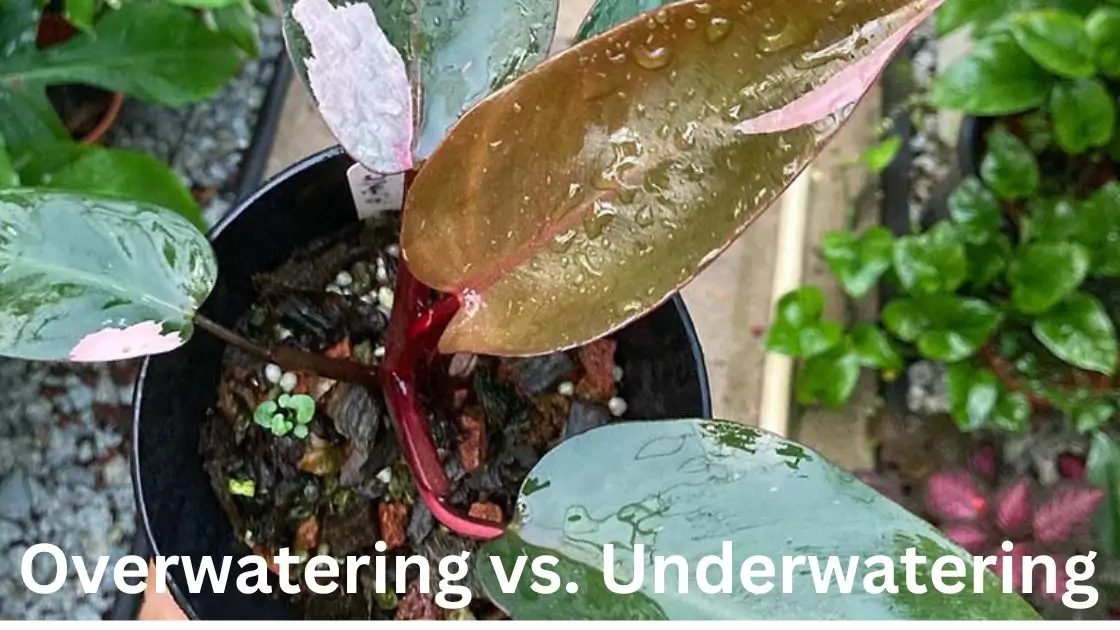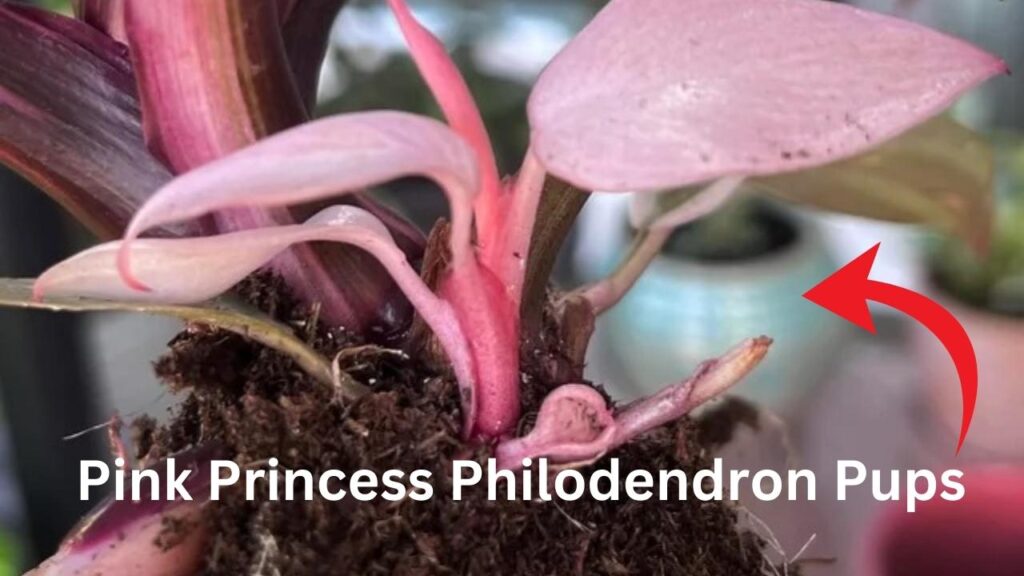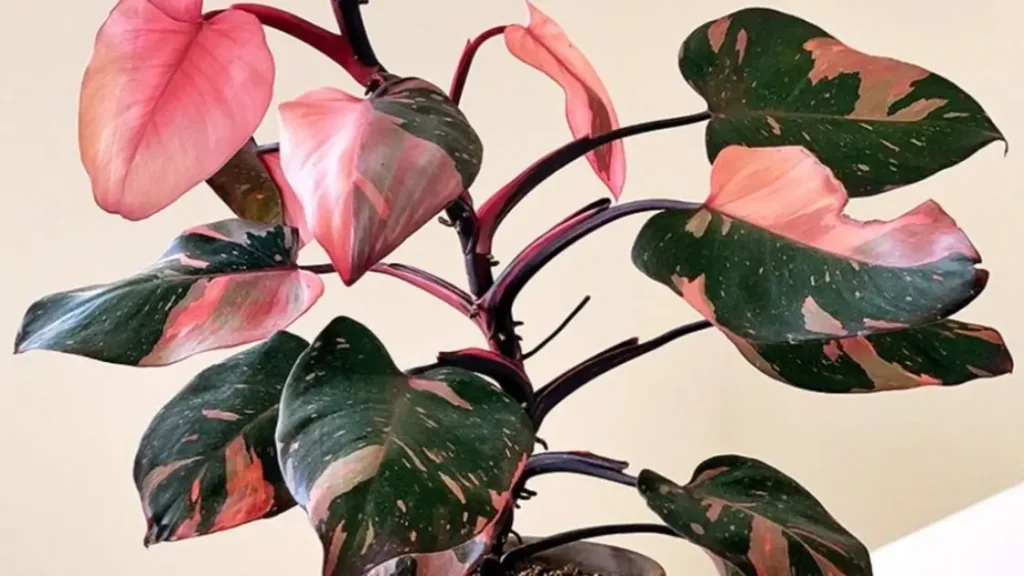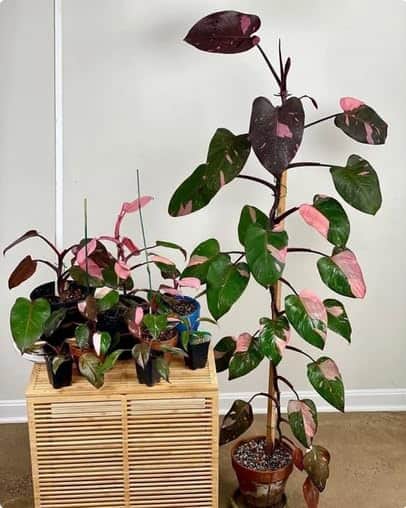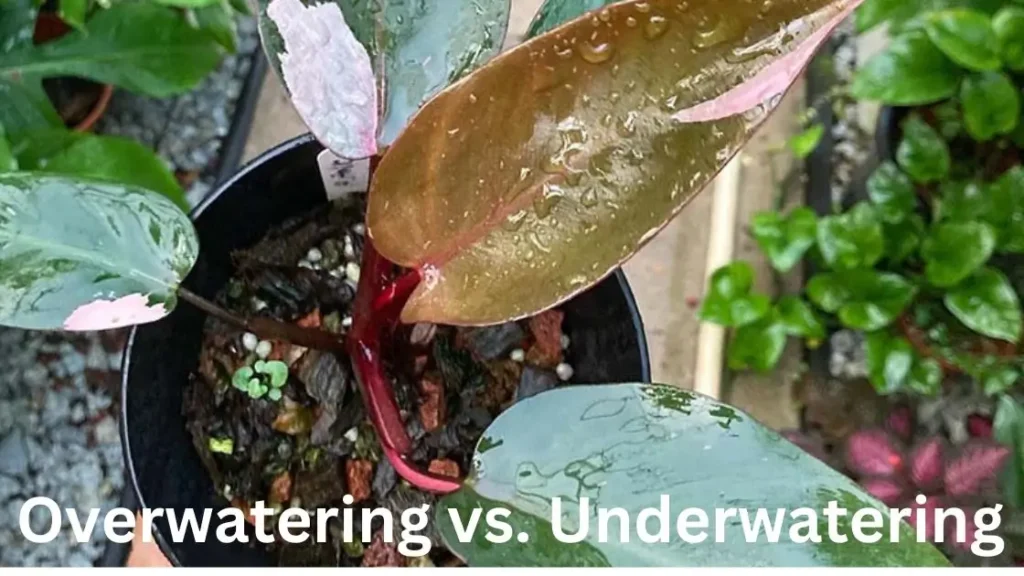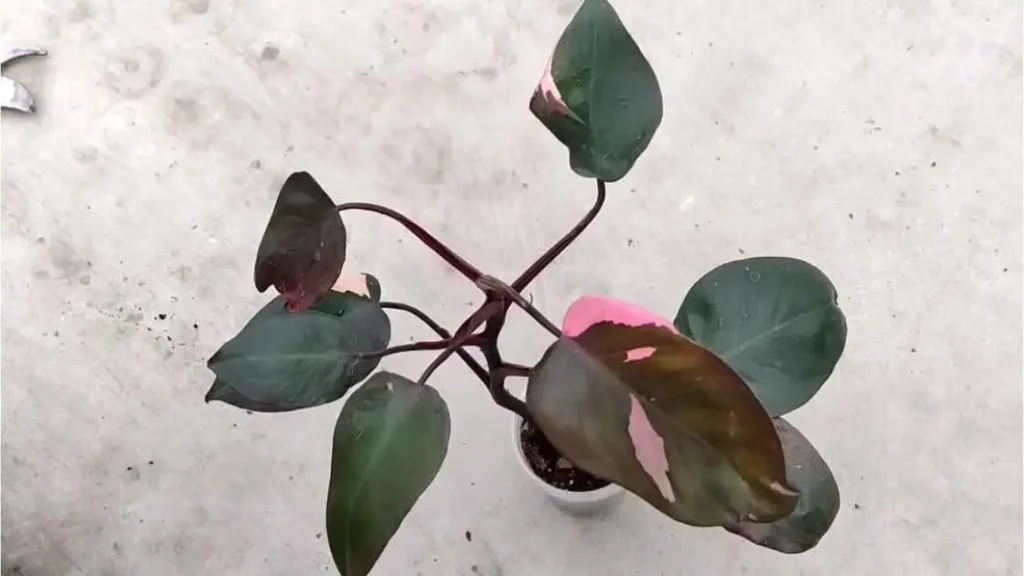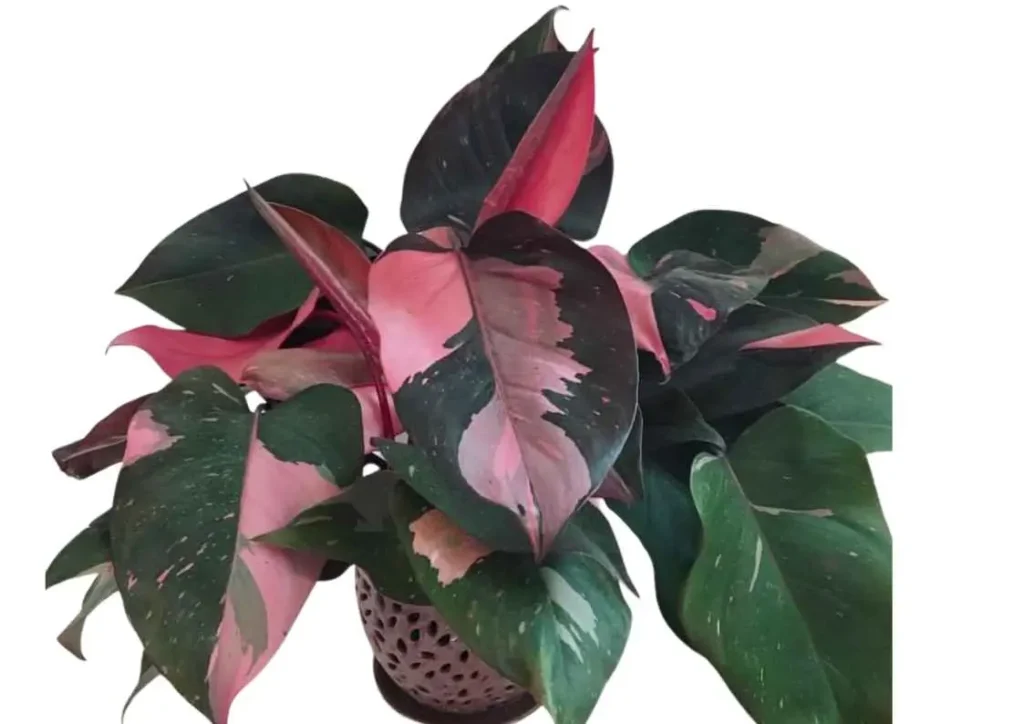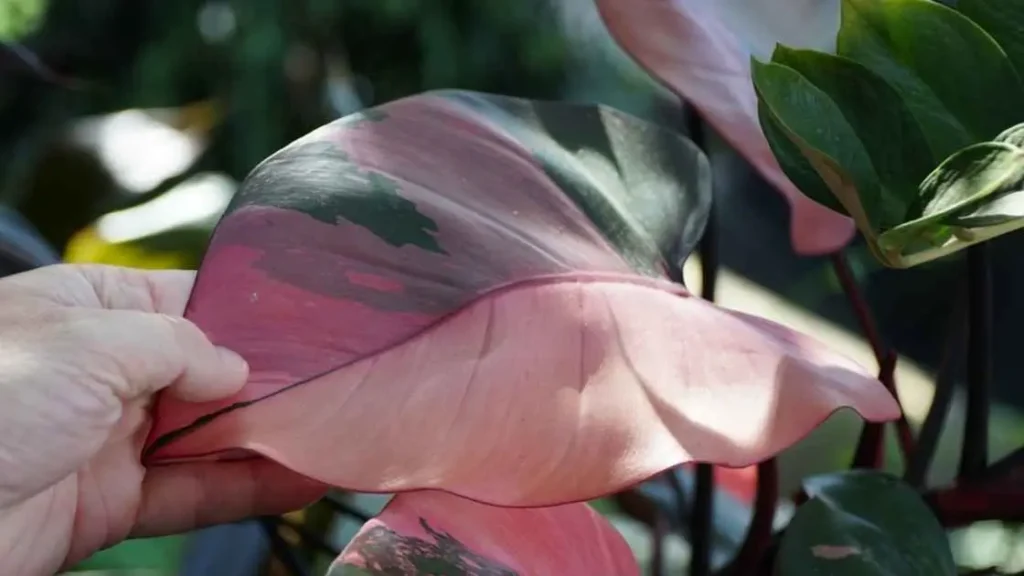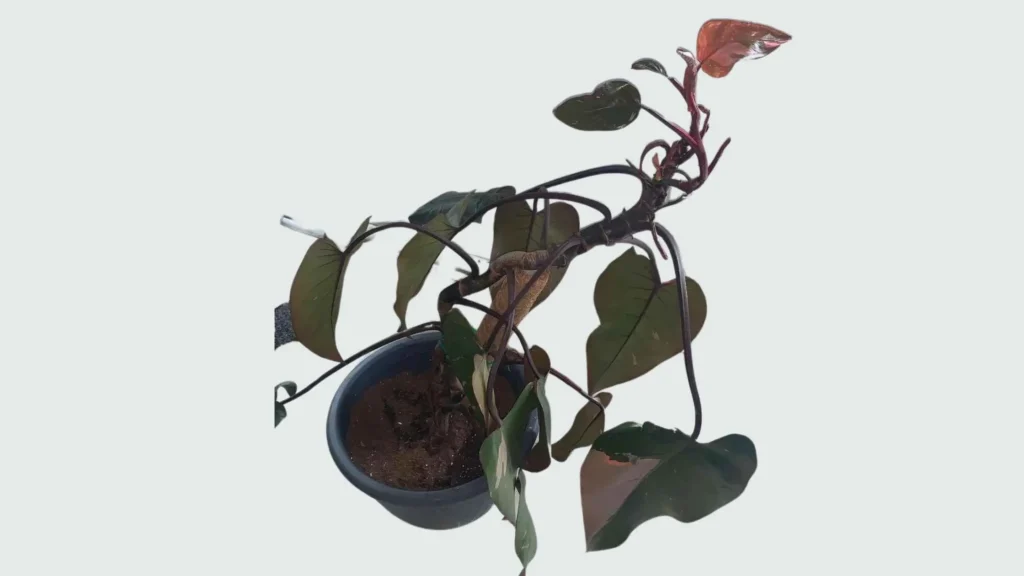Table of Contents
ToggleLet’s be honest—there’s something special about having a Pink Princess Philodendron in your home. Its bright pink and green leaves make it a favorite for plant lovers (and Instagram fans). But even though it’s beautiful, the Pink Princess can be tricky when it comes to water.
Too much water? You risk root rot and soft stems. Too little? Those pink leaves might turn brown and crispy. So, how do you find the right balance?
In this post, we’ll explore overwatering vs. underwatering, especially for your Pink Princess Philodendron. I’ll show you the signs of each problem, how to tell what your plant needs, and give you some tips to help it grow well. So, grab a coffee (or tea!) and let’s get started!
Understanding the Water Needs of a Pink Princess Philodendron
If you own a Pink Princess Philodendron, or want one, you know it needs the right amount of water. This plant comes from tropical areas and likes to stay moist. But here’s the challenge—too much water can be just as bad as too little.
Think of your Pink Princess like a friend who needs the right balance—not too much attention, and not too little. It prefers moist soil that drains well. The key is finding the balance between giving it too much or too little water.
So, how can you find that balance?
The Role of Water in Plant Health
Water is important for all plants, including the Pink Princess Philodendron. It helps the plant take in nutrients, make food, and stay cool. When water is soaked up by the roots, it brings nutrients from the soil. This helps the plant grow strong and healthy. Water also cools the plant, especially when it’s hot outside or indoors.
But too much water can be harmful. If the roots get too much water, they can’t get air, and the plant may get root rot. If there’s too little water, the plant can’t get the nutrients it needs. This makes the leaves droop, and the plant will stop growing.
Why Moisture Matters and Why Balance is Everything?
The Pink Princess grows best in places like tropical forests. These areas are humid, and the soil stays moist but not too wet. This is what we want to copy indoors.
If the soil gets too dry, the plant will feel stressed. If the soil stays wet too long, the plant might get sick, like from root rot. This is why it’s important to watch the soil moisture.
I always suggest checking the soil before watering. Stick your finger about an inch into the soil. If it feels dry, it’s time to water. If it’s still wet, wait a day or two before checking again. It’s better to wait than to water too early.
Overwatering: Signs and Consequences
We’ve all been there. You think you’re helping your plant by giving it extra water, but then you see its leaves turn yellow or start drooping. Overwatering is a common mistake for Pink Princess Philodendron owners, and it can really harm the plant.
So, how do you know if you’re giving your Pink Princess too much water? Let’s look at the signs and what could happen if you overwater it.
Signs of Overwatering
- Yellow Leaves: One of the first signs of overwatering is yellow leaves. This happens because the roots are sitting in water and can’t get enough air. The plant gets stressed. While yellow leaves can also be from other issues, overwatering is a common cause.
- Soft Roots: If your Pink Princess looks weak, check the roots. Healthy roots should be firm and white. If they are soft, dark, or smell bad, your plant has root rot. This happens when the soil is too wet for too long. It can kill the plant if not fixed fast.
- Wet Soil: Another sign of overwatering is always wet soil. If the soil feels wet days after watering, you might be watering too much. Good drainage is important, so make sure the pot has holes to let extra water out.
- Slow Growth: Over time, too much water can stop the plant from growing. When the roots are damaged, the plant can’t take in nutrients, and growth slows down or stops.
Consequences of Overwatering
Overwatering doesn’t just make your Pink Princess look unhealthy; it can cause long-term problems. Here are some issues you might face:
- Root Rot: This is the biggest issue. When the soil stays wet for too long, fungi and bacteria grow. Root rot happens when the roots don’t get enough air and start to rot. If you don’t treat it, it can kill your plant.
- Fungal Diseases: Overwatering can also cause fungal diseases. These can affect the leaves and stems. If you see brown or black spots on the leaves, it might be a fungus.
- Poor Air Flow: Too much water can make the soil tight, stopping air from getting to the roots. Plants need air, and if the roots don’t get enough, the plant will get weaker.
Underwatering: Signs and Consequences
If you don’t water your Pink Princess Philodendron enough, it can cause problems too. This happens if you’re busy or unsure about when to water it. Not giving your plant enough water might not show signs right away, but over time, it can get worse.
Here’s how to tell when your Pink Princess needs water and what happens if it stays thirsty for too long.
Signs of Underwatering
- Droopy, Wilting Leaves: If your Pink Princess looks droopy or limp, it may need water. When a plant doesn’t get enough water, its leaves lose strength and start to sag. Drooping could also mean overwatering, but if the soil feels dry, it’s likely underwatering.
- Crispy or Brown Leaf Edges: Check the leaf edges to see if your Pink Princess is too dry. When the soil is dry for too long, the edges of the leaves turn brown or crispy. This can make the plant look dull, and if it continues, the leaves may fall off.
- Slow or Stunted Growth: A thirsty Pink Princess won’t grow well. Without enough water, the plant can’t get the nutrients it needs, so its growth will slow down or stop.
- Curling Leaves: When the plant doesn’t get enough water, its leaves curl inward to save moisture. This is the plant’s way of showing it’s thirsty. If you see curled leaves, check the soil right away.
Consequences of Underwatering
Underwatering can hurt your Pink Princess Philodendron if it happens often. Here’s what might happen if your plant doesn’t get enough water:
- Leaf Drop: If the plant stays too dry, it may start dropping leaves. This is the plant’s way of needing less water to survive. It’s normal for old leaves to fall as the plant grows, but if many leaves drop, something is wrong.
- Dry Roots: If the soil stays dry too long, the roots dry out. This makes it harder for the plant to take in water, even when you water it. This can cause a cycle where the plant struggles after being watered.
- Slowed Growth: Without enough water, the plant’s processes slow down. Photosynthesis won’t work as well, so your Pink Princess won’t grow or keep its bright colors.
How to Revive an Underwatered Pink Princess?
The good news? It’s usually easier to save an underwatered Pink Princess than one that’s been overwatered. Start by giving it a deep soak. Water the plant until it drains from the bottom of the pot. Don’t rush—let the soil absorb the water evenly. You can also place the pot in a shallow tray of water for 30 minutes to help the roots get a good drink.
After watering, watch the soil moisture closely. Don’t let it dry out completely again. Check the soil often to find the right balance between watering too much and too little.
Key Differences Between Overwatering and Underwatering
It’s easy to mix up overwatering and underwatering, especially with a plant like the Pink Princess Philodendron. Both problems can make your plant droop, change color, or stop growing. That’s why it’s important to know the difference.
In this section, we’ll explain the main differences between overwatering and underwatering. This will help you figure out what’s wrong with your plant and fix the problem before it’s too late.
1. Soil Condition: Wet vs. Dry
- Overwatering: If the soil stays wet or soggy, this is a sign of overwatering. You may also smell a musty odor, which can mean root rot is starting. When you touch the soil, it will still feel wet even days after watering.
- Underwatering: If the soil is very dry, especially below the top inch, your plant may need water. The soil might even pull away from the edges of the pot when it’s too dry. This dryness stresses your Pink Princess and causes dehydration.
2. Leaf Condition: Yellow vs. Brown and Crispy
- Overwatering:
When a plant gets too much water, its leaves turn yellow. They may also feel soft and look limp. This happens because the roots sit in too much water and can’t get enough air. The plant starts to drown from the roots. - Underwatering:
If your Pink Princess doesn’t get enough water, the leaves turn brown and dry, especially at the edges. This is the plant trying to save water, but it means the plant needs more to stay healthy.
3. Root Health: Mushy vs. Dry
- Overwatering: If you’ve been giving your Pink Princess too much water, the roots may be damaged. Over time, they can become soft, mushy, and dark, which shows signs of rot. If you take the plant out of its pot and the roots smell bad or are falling apart, you’re likely dealing with serious overwatering.
- Underwatering: On the other hand, if the plant is not getting enough water, the roots will dry out and become brittle. When the soil is dry for too long, the roots shrink and won’t take in water well when you do water the plant. This makes it harder for the plant to bounce back from being too dry.
4. Growth Patterns: Stunted Growth in Both Cases
- Overwatering: If you give your Pink Princess too much water, the roots can’t take in nutrients well. The plant may stop growing, and new leaves might not open. In severe cases, the plant could die if the roots are too damaged.
- Underwatering: A plant that doesn’t get enough water will also grow slower. With less water, the plant’s growth slows down, and you will see fewer new leaves. Your Pink Princess may stay the same size for weeks or even months.
5. Leaf Curling and Drooping: A Shared Symptom
One of the tricky things about watering your Pink Princess plant is that too much or too little water can both make the leaves droop or curl. Here’s how to tell the difference:
- Overwatering: The leaves droop, but they stay soft. They may turn yellow.
- Underwatering: The leaves curl inwards and feel dry, especially at the edges.
Quick Tip: Use a Moisture Meter
If you’re not sure whether you are giving too much or too little water, a moisture meter can help. It checks the water in the soil better than just using your hands. This helps you know when to water or wait.
How to Properly Water a Pink Princess Philodendron?
Watering your Pink Princess Philodendron is important for keeping it healthy. You need to find the right balance. The plant needs enough water to grow, but not too much to drown the roots. So, how do you water it the right way?
Check the soil first. Let the top 1-2 inches dry out before watering again. If the soil still feels wet, wait a day or two. When you do water, make sure to water deeply, letting it drain out the bottom of the pot. This helps clean out any salt and gives the roots the water they need.
For more tips on how to water your Pink Princess, check out my full post. It covers common mistakes and techniques to keep your plant beautiful all year long.
Adjusting Your Watering Routine Based on Seasons
Your Pink Princess Philodendron needs more than just regular watering. Seasonal changes also affect it. Like other houseplants, its water needs change with the time of year.
Spring and Summer: The Growing Season
In spring and summer, your Pink Princess grows more. It will need more water to support new leaves. As the weather warms up and the days get longer, the soil will dry faster. You may need to water about every 7 to 10 days.
If your plant is in a bright spot with lots of indirect sunlight, the soil will dry even faster. Watch the moisture levels closely during these months and adjust your watering. Just remember not to water too soon—let the top layer of soil dry before watering again.
Fall and Winter: The Dormant Phase
When the cooler months come, your Pink Princess Philodendron slows down. It doesn’t grow much, so it needs less water. In fall and winter, water it every 2 to 3 weeks. This stops the roots from staying wet when the plant uses less water.
Watch out for indoor heating during winter. Heating can dry the air, and your plant might need more humidity. While you shouldn’t overwater, you can use a humidity tray or mist the plant to keep the air from getting too dry.
Factors to Consider
- Light Exposure: If your plant gets bright, indirect light, it will need more water than one in a shady spot.
- Pot Size and Material: Large pots hold water longer, while small pots dry faster. Terracotta pots pull water from the soil, but plastic or glazed pots keep it in.
By changing your watering routine for each season, you help your Pink Princess stay healthy all year. Remember, balance is key, and it’s important to watch your plant’s needs.
Additional Tips to Prevent Overwatering and Underwatering
Taking care of your Pink Princess Philodendron’s watering can be tricky. But with some simple tips, you can keep your plant healthy. You can also avoid watering too much or too little.
1. Check Soil Moisture Regularly
The best way to stop overwatering and underwatering is to check the soil often. Stick your finger about an inch into the soil. If it feels dry, it’s time to water. If it feels wet, wait a few days and check again.
If you want to be more exact, you can buy a moisture meter. This tool helps you check the water level, so you’ll know when your Pink Princess plant needs water.
2. Ensure Proper Drainage
One easy way to overwater your plant is by using a pot without holes. Always use a pot with holes, so extra water can drain out. This keeps water from sitting at the bottom, which can cause root rot.
For better results, put pebbles at the bottom of the pot. You can also use a special soil mix that drains well for philodendrons.
3. Adjust Based on Environmental Factors
Temperature and light affect how fast the soil dries. If your plant is in a bright area with indirect light, the soil will dry faster, and you’ll need to water more often. Warm temperatures and low humidity can also dry the soil quickly. Adjust your watering based on these conditions.
On the other hand, if your Pink Princess is in a cool room or gets less light, water less often since the soil will stay wet longer.
4. Don’t Stick to a Rigid Schedule
It might seem easy to water your plant every week, but it’s better to wait until the plant needs it. The conditions in your home change all the time. Things like temperature, light, and humidity can affect how much water your plant needs. Instead of watering every Sunday just because it’s on your schedule, check the soil and see how your plant is doing.
5. Use Room-Temperature Water
Here’s a quick tip that can help a lot—always use water at room temperature when watering your Pink Princess Philodendron. Cold water can hurt the roots, and hot water can do damage. Room-temperature water keeps your plant safe and healthy.
Common Watering Mistakes and How to Fix Them?
Even with the best care, it’s easy to make watering mistakes. This is especially true with a plant as delicate as the Pink Princess Philodendron. Here are some common mistakes I’ve seen and how to fix them:
1. Overwatering After Underwatering
It’s easy to want to fix underwatering by giving your plant a lot of water. But this can hurt the roots and cause overwatering. Instead, slowly water more often so the plant can get used to it.
2. Watering on a Strict Schedule
Many plant owners water once a week without thinking about what the plant needs. Instead of sticking to a schedule, watch the plant and check the soil. Pink Princess Philodendrons don’t follow your calendar—they follow their environment.
3. Forgetting to Check Drainage
Water sitting at the bottom of the pot can quietly harm your plant. If your pot doesn’t drain well, the extra water will stay there and cause root rot. Always use pots with drainage holes and don’t let water sit in saucers too long.
4. Using Cold or Hot Water
If you’ve been using cold or hot water from the tap, stop! This can shock the roots and hurt your plant. Use room-temperature water—it’s safer and better for your Pink Princess.
5. Not Adjusting for Environment Changes
Changes in light, humidity, and temperature happen throughout the year. Your watering routine should change too. For example, in winter, water less because the plant doesn’t grow as much.
How to Fix These Mistakes?
If you’ve made one of these mistakes, don’t worry! Plants can bounce back if you act quickly. Here’s how to fix some common problems:
- For overwatered plants: Stop watering, let the soil dry, and check for good drainage. If the roots are rotting, repot the plant in fresh, well-draining soil.
- For underwatered plants: Rehydrate slowly. Start with a good soak, but don’t drench it too fast.
Learning from these mistakes will help you improve your watering and create a better space for your Pink Princess.
Conclusion
Taking care of a Pink Princess Philodendron can seem hard when it comes to watering. But once you know what it needs, it gets easier. The goal is to find the right amount of water—not too much, not too little.
Whether you’ve been giving too much water, too little, or just want to improve, the key is to watch your plant. Pay attention to its signs and the environment around it.
Check the soil moisture, change your routine with the seasons, and avoid common mistakes. This way, your Pink Princess will grow strong and healthy. The best part? You’ll enjoy its pretty pink and green leaves without worrying about how to water it.
Now that you know more, happy growing!
FAQs
How do I know if I’m overwatering my Pink Princess Philodendron?
If the leaves turn yellow, the soil stays wet for days, or the roots become soft, you are likely overwatering. Drooping leaves can also be a sign.
What are the signs of underwatering a Pink Princess Philodendron?
Signs of underwatering include brown, dry leaf edges, drooping, and dry soil. The plant may also have curled leaves and grow more slowly or stop growing.
When should I water my Pink Princess Philodendron?
Water your plant when the top inch of soil feels dry. You can use a moisture meter to make sure the plant gets the right amount of water.
Can overwatering cause root rot?
Yes, overwatering causes soil to stay too wet. Roots need air, and too much water stops them from breathing, which leads to root rot. Proper drainage helps prevent this.
Which is easier to fix: overwatering or underwatering?
Underwatering is easier to fix. Water your plant slowly and let the soil soak it up. Overwatering can lead to root rot, which may require repotting and cutting off damaged roots.
How often should I water my Pink Princess Philodendron?
In spring and summer, water every 7-10 days. In fall and winter, water every 2-3 weeks. Always check the soil moisture before watering.
Related
Discover more from Pink Philodendron
Subscribe to get the latest posts sent to your email.

